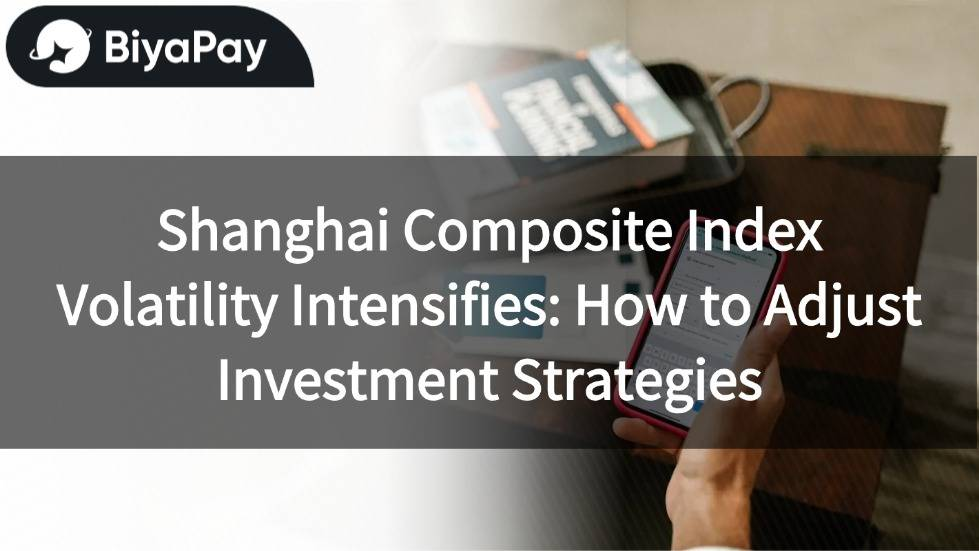- EasyCard
- Trade
- Help
- Announcement
- Academy
- SWIFT Code
- Iban Number
- Referral
- Customer Service
- Blog
- Creator
Shanghai Composite Index Volatility Intensifies: How to Adjust Investment Strategies

Image Source: pexels
In 2025, the Shanghai Composite Index exhibits significant volatility, and investors facing global market chain reactions need to closely monitor capital flows and policy changes. Historical data shows that when the U.S. S&P 500 Index corrects, global risk assets face simultaneous pressure. China recently rolled out a USD 1.4 trillion stimulus package, coupled with monetary policy adjustments, providing support for asset prices. As market fragility increases, flexibly adjusting investment strategies becomes critical.
Key Points
- In 2025, the Shanghai Composite Index experiences heightened volatility, and investors should closely monitor policy changes and international economic data to flexibly adjust investment strategies.
- Short-term investments require strict stop-loss measures and the use of technical indicators to gauge trends, mid-term focus should be on policy-favored industries, while long-term strategies emphasize diversified asset allocation to mitigate risks.
- Market sentiment indicators such as ETF premiums, put-call ratios, and VIX volatility help assess investor confidence, and investors should adjust positions based on these indicators.
- A diversified portfolio can effectively reduce risks and enhance stable returns, with regular portfolio reviews and stop-loss points being key to risk management.
- Maintaining a rational investment mindset, setting clear goals, and avoiding emotional decisions help achieve steady growth in volatile markets.
Shanghai Composite Market Dynamics

Image Source: pexels
Recent Trends
In mid-June 2025, the Shanghai Composite Index remains in the 3380 to 3400 point range. Compared to approximately 2632 points at the end of May, the index has significantly rebounded. In terms of price-to-earnings (P/E) ratio, the static P/E ratio at the end of May was about 26.72 times, indicating a relatively high valuation range. By mid-June, the P/E ratio dropped to around 12.5 times, suggesting valuations have returned to a more reasonable level. Some bank stocks offer dividend yields exceeding 5%, attracting long-term capital attention. Trading volume shows increased market activity, with capital flows stabilizing.
Recent technical indicators suggest a narrowing volatility range. Trend-following indicators such as Moving Average (MA), MACD, and Bollinger Bands indicate that the Shanghai Composite Index is likely to maintain a consolidation pattern in the short term. Contrarian indicators like RSI, KD, and BIAS help investors determine whether the market is overbought or oversold. The VIX Index has dropped to a new low, signaling reduced risk aversion and gradually recovering confidence. Since April, developed markets have outperformed emerging markets, and investor concerns about economic recession have eased.
In June 2025, the Shanghai Stock Exchange launched the SSE STAR Market Composite Index, further enriching the market’s index system. The SSE 180 Index constituents were also adjusted to enhance market representation. Capital flows through Shanghai-Hong Kong and Shenzhen-Hong Kong Stock Connect remain stable, with sustained foreign inflows reflecting international investor confidence in China’s capital markets.
Investors can observe P/E ratios, trading volumes, and technical indicators to gauge market activity and valuation levels, providing a basis for subsequent investment decisions.
Market Sentiment
In mid-June 2025, market sentiment leans cautious. Blue-chip stocks’ valuations are near their lows, and the central bank’s interest rate cuts and reserve requirement reductions help stabilize market expectations. Global equity risk appetite indicators show that MSCI Emerging Markets ETF premium/discount dropped from 66 to 40, with investor allocation ratios falling from 50 to 44, reflecting declining confidence. The CBOE put-call ratio decreased from 88 to 64, indicating easing bearish sentiment. The consensus bullish sentiment index fell from 62 to 28, turning investor sentiment pessimistic. The cyclical/defensive sector shift in emerging markets dropped from 45 to 14, signaling lower expectations. The CBOE S&P 500 VIX Index fell from 29 to 7, significantly reducing market uncertainty.
Regional risk appetite indicators show that emerging markets and most Asian markets are in or near panic zones. Japan and some countries remain in neutral zones, while markets like China, Hong Kong, and Singapore have retreated from optimistic zones. These indicators quantify changes in market sentiment, helping investors assess confidence and risk appetite.
- Market Sentiment Indicators Summary:
- Positioning Factors: ETF premium/discount, allocation ratios
- Put-Call Ratio: Reflects bearish or bullish sentiment
- Survey Factors: Professional institutions’ consensus sentiment
- Technical Analysis: Cyclical/defensive sector shifts
- Volatility Index: VIX reflects market uncertainty
Investors should closely monitor changes in market sentiment indicators, combining Shanghai Composite valuations and capital flows to flexibly adjust investment strategies.
Causes of Volatility
Policy and Economy
In spring 2025, the Shanghai Composite Index experienced significant volatility, with policy adjustments and economic data as primary drivers. China continues to advance STAR Market reforms, with regulators strengthening oversight of capital markets to enhance transparency. These measures help attract long-term capital but may trigger short-term volatility.
Following the inauguration of the new U.S. administration, policy changes have been frequent, including tariff adjustments, federal spending cuts, and tightened immigration policies, leading to fluctuations in global business confidence indicators. The S&P Global U.S. Services PMI fell sharply by over 7 points, reflecting weakening market sentiment. The U.S. Producer Price Index (PPI) rebounded consecutively since hitting a low in June 2025, with core CPI and PPI data indicating persistent inflationary pressure, and markets expect the Federal Reserve to maintain high interest rates.
Investor capital flows have also shifted significantly, moving from large-cap growth stocks to defensive sectors, with a steepening bond yield curve and low corporate bond credit spreads, indicating market concerns about recession risks are closely tied to policy adjustments.
The 3305-point level became a key resistance in spring 2025, with the market maintaining a consolidation pattern in the short term, while long-term trends depend on further policy and economic data developments.
International Factors
International dynamics also influence Shanghai Composite volatility. Easing tensions in the Middle East have reduced global energy price fluctuations, bringing some market stability. The U.S. overall PPI annual rate rose to 1.6% in August, marking the largest increase in over a year, with core PPI and CPI data both exceeding 4%, indicating persistent inflationary pressure.
As a result, markets expect the Federal Reserve to delay rate cuts, leading to adjustments in capital flows and increased volatility in stock and bond valuations.
Additionally, stable capital flows through Shanghai-Hong Kong and Shenzhen-Hong Kong Stock Connect, with financial institutions like Hong Kong banks continuing to attract international capital, enhance the internationalization of China’s capital markets.
In the short term, international capital flows and policy expectations will continue to drive market volatility, and investors need to closely monitor global economic data and geopolitical changes.
Investment Strategy Adjustments

Image Source: pexels
Amid the intensified volatility of the Shanghai Composite Index in 2025, investors need to flexibly adjust strategies based on different investment horizons. Professional investors typically categorize strategies into short-term, mid-term, and long-term, combining market data, industry trends, and policy changes to enhance portfolio stability and return potential.
Short-Term Strategies
Short-term operations emphasize flexibility in responding to market volatility. Investors can use technical analysis tools like Moving Average, MACD, and RSI to gauge the Shanghai Composite’s short-term trends. During significant market swings, short-term traders should set strict stop-loss points to control single-trade loss risks.
Professional fund managers closely track trading volume, market sentiment indicators, and capital flows to quickly adjust position sizes. For example, when market sentiment turns pessimistic, investors may reduce high-volatility assets and increase cash or short-term bond allocations.
Short-term strategies suit investors with high risk tolerance and strong market sensitivity. These strategies require investors to stay highly alert and leverage financial data tools to promptly produce professional reports, tracking portfolio performance and risk metrics.
Tip: Short-term operations require strict discipline to avoid emotional decisions impacting outcomes.
Mid-Term Deployment
Mid-term deployment focuses on sector rotation and stock selection. Investors can focus on policy-favored sectors, such as new energy, technological innovation, and consumption upgrades, based on the Shanghai Composite’s sector structure changes.
Professional analysts use historical financial data and relative value analysis to assess growth potential and valuation levels across industries. Through systematic financial data compilation and report production, investors can compare risk-adjusted returns of industries and stocks, selecting those with competitive advantages and stable cash flows.
Mid-term strategies emphasize dynamic adjustments, reallocating sector weights based on market conditions and policy guidance. This approach helps capture sector rotation opportunities while diversifying single-sector risks.
- Mid-Term Deployment Focus:
- Focus on policy-driven industries
- Use data analysis for stock selection
- Regularly review portfolio structure
Long-Term Allocation
Long-term allocation centers on asset diversification and defensive portfolios. Historical data shows that multi-asset strategies effectively enhance portfolio resilience, reducing the impact of single-market volatility on overall returns.
Schroder Investment Management’s “Taiwan Equity + U.S. Bonds” multi-asset strategy combines Taiwan equities’ long-term growth potential with the defensive capabilities of U.S. investment-grade bonds, demonstrating stability during market volatility. U.S. investment-grade bonds offer higher yields during rate-hike cycles, providing both defensive and income benefits. The low correlation between Taiwan equities and U.S. bonds, combined with diverse asset classes and regional markets, enhances portfolio risk management.
Dynamic asset allocation strategies have been tested in multiple market volatilities from 2018 to 2023, including the U.S.-China trade war, the pandemic, and Federal Reserve rate hikes. Long-term annualized compound growth rates range from approximately 10% to 18%, outperforming traditional single-market allocations. These strategies blend active and passive investment benefits, suitable for long-term investors seeking efficiency and stable growth.
- Long-Term Allocation Advantages:
- Dynamic risk diversification
- Stable return enhancement
- Strengthened portfolio resilience
Investors should flexibly adjust short-term, mid-term, and long-term strategies based on their risk tolerance and investment goals. Combining the Shanghai Composite’s daily fluctuations with long-term trends, while continuously monitoring policy and sector performance, helps enhance overall investment outcomes.
Risks and Mindset
Risk Management
When facing Shanghai Composite volatility, investors must establish effective risk management mechanisms. Diversified portfolios are a common strategy among professional investors. According to 2014–2024 data on Taiwan’s 0050 ETF and U.S. S&P 500 Index annualized returns and risk scatter plots, diversification effectively reduces volatility while maintaining stable returns. In 1952, Harry Markowitz introduced Modern Portfolio Theory, mathematically proving that diversification can reduce risk without sacrificing returns. This strategy leverages low correlations between assets to offset market volatility, enhancing risk resistance.
In practice, the 0050 ETF and S&P 500 Index, covering multiple industries and companies, successfully diversify risks, demonstrating stability and long-term growth potential during market volatility. Diversification not only mitigates risks but also captures growth opportunities across different markets and economic cycles, laying the foundation for long-term stable wealth growth.
Professional investors recommend regularly reviewing asset allocations, adjusting portfolio structures based on market changes, and setting stop-loss points to prevent significant losses from single assets.
Investment Mindset
A sound investment mindset is key to long-term success. During market volatility, investors are prone to panic or over-optimism. Professional investors emphasize replacing emotional decisions with rational analysis. Investors can cultivate a stable mindset through the following methods:
- Set clear investment goals to avoid short-term volatility disrupting long-term plans
- Regularly review portfolios, maintain discipline, and avoid rash strategy changes due to market sentiment
- Learn basic financial knowledge to enhance market understanding and judgment
Investors should understand that short-term market fluctuations are normal. By adhering to diversified allocations and rational decisions, steady returns can be achieved over the long term.
In 2025, with intensified Shanghai Composite volatility, investors should adopt the following strategies:
- U.S. long-term Treasuries have a negative correlation with equities, 1-year at -0.49, 3-year at -0.391, and diversified assets can reduce risks.
- Diversified portfolios offer more stable long-term returns, with a $10,000 investment growing significantly over 20 years compared to single stocks.
- During the pandemic, ETF trading volumes surged, and flexible portfolio adjustments helped navigate market changes.
Investors should continuously monitor markets and rationally adjust strategies based on their risk tolerance and goals.
FAQ
How should investors adjust asset allocation during intensified Shanghai Composite volatility?
Investors can consider diversifying assets, combining equities, bonds, and cash. Professionals recommend regularly reviewing portfolios and flexibly adjusting based on market changes.
How can technical indicators be used to time market entry?
Technical indicators like MACD, RSI, and Moving Average help analyze short-term trends. Investors can set buy or sell strategies based on indicator signals.
How should long-term investors handle short-term market volatility?
Long-term investors can focus on asset diversification and defensive portfolios. Maintaining discipline and avoiding frequent strategy changes due to short-term volatility helps enhance long-term returns.
What international factors should be noted when investing in the Chinese market?
International capital flows, USD exchange rates, and global economic data impact the Chinese market. Investors should closely monitor U.S. interest rate policies and geopolitical changes.
What advantages do Hong Kong bank products offer in asset allocation?
Hong Kong banks provide diversified USD asset products integrated with global capital markets. Investors can leverage their international platforms to enhance asset allocation flexibility.
The volatile Shanghai Composite Index in 2025 demands agile investment strategies, but high fees and opaque exchange rates often erode returns. BiyaPay offers a streamlined solution to these challenges. With just one account, you can trade U.S. and Hong Kong stocks in real-time without the hassle of opening overseas accounts, seamlessly connecting you to global markets.
Its real-time exchange rate queries and conversions across multiple fiat and digital currencies help mitigate rate fluctuations. Transaction fees as low as 0.5% ensure cost efficiency, while quick registration gets you started instantly. Visit BiyaPay now to access a powerful, transparent platform and elevate your investment strategy in today’s dynamic market!
*This article is provided for general information purposes and does not constitute legal, tax or other professional advice from BiyaPay or its subsidiaries and its affiliates, and it is not intended as a substitute for obtaining advice from a financial advisor or any other professional.
We make no representations, warranties or warranties, express or implied, as to the accuracy, completeness or timeliness of the contents of this publication.




Contact Us
Company and Team
BiyaPay Products
Customer Services
is a broker-dealer registered with the U.S. Securities and Exchange Commission (SEC) (No.: 802-127417), member of the Financial Industry Regulatory Authority (FINRA) (CRD: 325027), member of the Securities Investor Protection Corporation (SIPC), and regulated by FINRA and SEC.
registered with the US Financial Crimes Enforcement Network (FinCEN), as a Money Services Business (MSB), registration number: 31000218637349, and regulated by FinCEN.
registered as Financial Service Provider (FSP number: FSP1007221) in New Zealand, and is a member of the Financial Dispute Resolution Scheme, a New Zealand independent dispute resolution service provider.




















